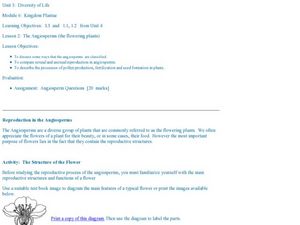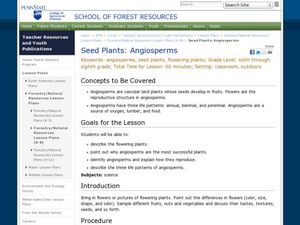Curated OER
Introduction to Plants
A vast overview of avascular and vascular plants, this PowerPoint displays all of the notes your botanists need to take. It lists primitive plant groups and their characteristics. It separates gymnosperms and angiosperms, also detailing...
Curated OER
Seed Plant Reinforcement
In this plant worksheet, students contrast gymnosperms and angiosperms by completing a table and using information from their textbook. They also identify 5 plants as either monocot or dicot and complete 3 short answer questions about...
Curated OER
Feed Me, Seymour
Learners work in small groups to create posters illustrating the major facts and functions of plant organs. Within their groups, they assume the role of specialists creating specialized posters pertaining to the different parts of plants.
Curated OER
The Angiosperms
Students study angiosperms and their classifications. In this investigative lesson students compare the sexual reproduction of angiosperms and seed formations.
Curated OER
Seed Plants: Angiosperms
Students describe flowering plants and see why angiosperms are the most successful plants. In this angiosperms lesson students identify angiosperms and explain how they reproduce.
Curated OER
How Do Plants Reproduce?
In this plant reproduction worksheet, students will complete a Venn diagram by comparing and contrasting gymnosperms and angiosperms.
Curated OER
Monocots vs. Dicots
Learners examine the differences in nonvascular and vascular plants. They compare the differences between gymnosperm and angiosperms. Students compare the differences between moocots and dicots. They view a powerpoint presentation on...
Curated OER
Fun with Phylogenetic Trees
Tenth graders differentiate angiosperms and gymnosperms. In this biology instructional activity, 10th graders construct a musical phylogenetic tree from information they gathered on resource websites. They present their project in class.
Curated OER
Flower Structure and Reproduction
For this flower structure worksheet, students read the information on flower structure and reproduction. Students answer questions based on the reading provided.










